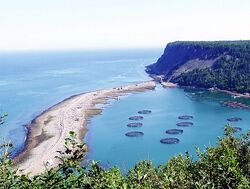Earth:Barachois
This article needs additional citations for verification. (December 2009) (Learn how and when to remove this template message) |
A barachois is a term used in Atlantic Canada, Saint Pierre and Miquelon, Réunion and Mauritius to describe a coastal lagoon partially or totally separated from the ocean by a sand or shingle bar. Sometimes the bar is constructed of boulders, as is the case at Freshwater Bay near St. John’s, Newfoundland. Salt water may enter the barachois during high tide.
The bar often is formed as a result of sediment deposited in the delta region of a river or – as is the case in Miquelon – by a tombolo.
Name
The English term comes from the French language, where the word is pronounced [ba.ʁa.ʃwa].
The term comes from a Basque word, barratxoa, meaning little bar. The popular derivation from the French barre à choir is without historical merit.
In Newfoundland English, the word has become pronounced as barshwa.
Examples
- Dark Harbour, Grand Manan, New Brunswick (photo)
- Barachois de Malbaie on the tip of the Gaspé Peninsula, fed by one of two Malbaie Rivers in Quebec and the Beattie, du Portage, and Murphy Rivers
- Grand Barachois, Miquelon Island
- Grand-Barachois, in Westmorland County, New Brunswick
- Barachois Pond Provincial Park in western Newfoundland
- Big Barasway and Little Barasway, communities on Newfoundland's Cape Shore
- Prince Edward Island National Park has several examples
- Percival Bay, off the Northumberland Strait, is also known as the Big Barachois
- The coves in the lagoon of Diego Garcia in the Indian Ocean
- Topsail Beach Provincial Park, Topsail
- Former settlement of Freshwater, near St John's, Newfoundland.
- Great Barachois, near Petit-de-Grat, Nova Scotia
References
 |


